When we talk about Red Terror Cichlids, the first thing that comes to mind is their beautiful red color. But there’s more to this cichlid than just its good looks. These fish are also known for being aggressive and territorial, which means they’re not the best choice for a community tank.
But if you’re looking for a stunning centerpiece fish for your freshwater Aquarium, the Red Terror Cichlid is a great option. They are found in Ecuador and Northern Peru. They are natively found in rivers across western South America.
The Red Terror Cichlid female is slightly smaller than the male and has a more rounded belly. The fins of the female are also shorter. The female is bright red and orange with dark vertical stripes. The males are iridescent green with patches of red and orange and dark lines.
They come from the Cichlidae family, also known as Harlequin cichlid or New World Cichlids. The scientific name for the Red Terror Cichlid is Heros festae.
This article will take a closer look at the Red Terror Cichlids, including their appearance, behavior, and ideal tank conditions. We’ll also give you tips on caring for these fish so you can successfully add them to your Aquarium.
Table of Contents
Species Summary
| Scientific Name: | Heros festae |
| Care Level: | Easy to Moderate |
| Temperament: | Aggressive and boisterous |
| Temperature Range: | 77°–84°F |
| Common Names: | Guayas Cichlid, Harlequin Cichlid, Red Terror |
| Color: | Bright red with dark vertical stripes |
| Lifespan: | 12–20 years |
| Size: | 13–18 inches |
| Diet: | Omnivore |
| Family: | Cichlidae |
| Minimum Tank Size: | 180 gallons |
| Tank Setup: | Large rocks, sand, and floating plants |
| Water pH Level: | 7-8 |
| Compatibility: | Large, aggressive fish |
Red Terror Cichlid Size and Growth
The size of Red Terror Cichlid fish can range from 13 to 18 inches. Females are typically smaller than males, but both sexes can reach the upper end of this size range. These cichlids proliferate and can get their full size within two years if they are well cared for and have plenty of space to grow.
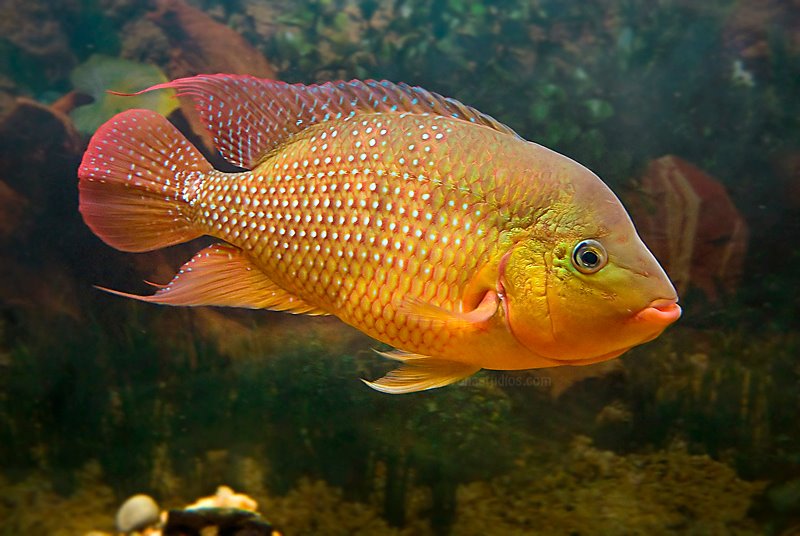
Check: Jaguar Cichlids Care: Appearance, Lifespan
Red Terror Cichlid Lifespan
The lifespan of a Red Terror Cichlid is 12 to 20 years. This long lifespan is partly due to their robust health and hardy nature. These fish are relatively resistant to disease and can thrive in many water conditions.
Red Terror Cichlid Appearance
The appearance of these fishes is very striking. The base color of their body is bright red, and they have dark vertical stripes running down their sides. The fins are also typically red or orange, with some darker lines.
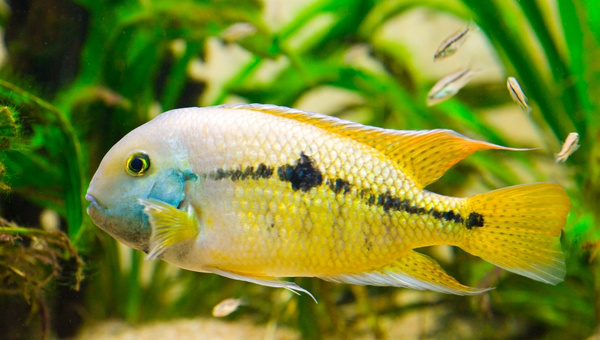
Females tend to be more brightly colored than males, but both sexes are pretty beautiful. Breeding females are a lot brighter than juveniles. As the males grow, their colors fade, producing a prominent nuchal hump on their forehead by age three.
The Red Terror Cichlid is a large fish, and males can reach up to 18 inches in length. Females are typically a bit smaller, but both sexes have the potential to reach this size. The body is deep and compressed, with a large head and mouth. The fins are all large and well-developed, and the tail is forked.
Also, check: Jewel Cichlid Care Guide: Appearance, Size, Diet & All
Red Terror Cichlid Behavior and Temperament
Red Terror Cichlids are aggressive and should only be kept with other aggressive fish. They are not recommended for beginners.
Red Terror Cichlids will often establish a hierarchy in the tank. The most aggressive fish will be at the top of the scale. The order will determine who gets to eat first and who gets the best hiding spots.
If you keep more than one Red Terror Cichlid, you should provide plenty of hiding spots. This will help reduce aggression. Red Terror Cichlids are also known to be fin nippers. They may nip the fins of other fish in the tank.
You can provide hiding spots and reduce aggression by keeping your Red Terror Cichlid in a tank of at least 50 gallons. It would help if you also offered plenty of rocks and caves for them to hide in.
False Red Terror
These fishes are often confused with the much rarer Mayaheros urophtalmus species, also known as the False Red Terror. These fish are similar in size and shape, and they both have a red coloration with dark vertical stripes.
The easiest way to tell these two species apart is by looking at the fins. The False Red Terror has black edging on the fins, which is not present on the Red Terror Cichlid. In addition, the False Red Terror has a more rounded body shape, while the Red Terror Cichlid is more compressed.
False Red Terror Cichlids are sometimes sold as true Red Terror Cichlids in pet stores, so be sure to ask the seller which species you are getting before making a purchase.
Red Terror Cichlid Breeding
Red Terror Cichlids are monogamous and will pair for life. They are also known to be protective of their eggs and fry. Forcefully pairing two Red Terror Cichlids together can result in death, as they will fight with each other.
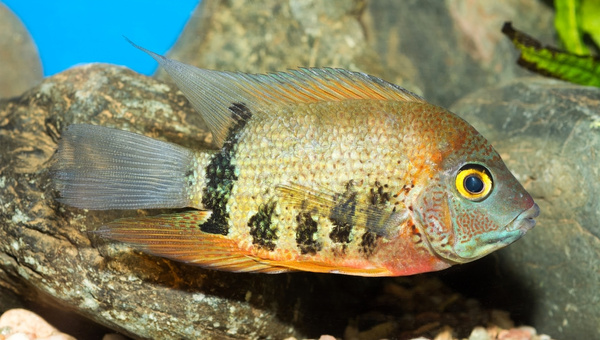
To encourage breeding, you should increase the water temperature to 86 degrees Fahrenheit. You should also provide plenty of hiding spots for the female to lay her eggs. The male will then fertilize the eggs.
The female will lay up to 500 eggs and hatch within four days. The fry will be free swimming after 5-7 days.
You should feed the fry live foods such as brine shrimp or daphnia. You can also feed them crushed flakes or pellets.
You should remove the parents from the tank after the fry is free swimming. The parents may eat the fry if they are left in the tank.
If you want to keep the fry, you should provide plenty of hiding spots for them. You should also perform regular water changes to keep the fry healthy. The fry will reach maturity in 6-8 months.
Red Terror Cichlid Care Guide
Caring for these fish is not complex, but providing them with a large tank is essential. They need at least 180 gallons, and more is better. The tank should be decorated with large rocks, driftwood, and some floating plants.
These fish like to dig, so a layer of sand or gravel on the bottom of the tank is also recommended. You must change the tank water often to keep the environment clean. The tank will need plenty of filtration and maintenance.
Red Terror Cichlids are not picky eaters and will accept most types of food. They should be fed various foods, including pellets, flakes, freeze-dried foods, and live or frozen foods. Feed them several times a day in small amounts to eat all their food before it sinks to the bottom of the tank.
These fishes are aggressive and must be kept with other large, aggressive fish. They can be controlled with other cichlids and catfish, barbs, and danios. Avoid keeping them with smaller fish, as they may become snacks.
You may also check: Butterfly Betta Care Guide: Appearance, food & Diet, Breeding & All
Red Terror Cichlid Tank Size
The minimum tank size for these fish is 180 gallons, but the bigger, the better. These fish are active and need plenty of space to swim. They also produce a lot of waste, so a larger tank is necessary to keep the water clean with the help of a solid biological filtration system.
These fishes are sensitive to organic waste, so you should change the tank water at least once a month, with partial water changes each week.
Your tank setup should mimic the fish’s natural environment. Their natural habitat is abundant with food sources, so provide them with plenty of rocks and driftwood for hiding places. They also like to dig, so a layer of sand or gravel on the bottom of the tank is recommended.
Also, check: African Cichlid Care Guide: Diet, Tankmates, Lifespan & All
Water Parameters
Red Terror Cichlids can survive in various water parameters as they’re used to a changing environment in the wild, but they prefer a neutral to slightly alkaline pH with a hardness of 10-20 dGH. The temperature should be around 77° to 84°F.
You should often test your water parameters to ensure they are within the ideal range. If you need to adjust the pH, do so slowly over a few weeks to avoid stressing the fish.
Tank Decorations
Your tank setup should mimic the fish’s natural environment. Their natural habitat is abundant with food sources, so provide them with plenty of rocks and driftwood for hiding places.
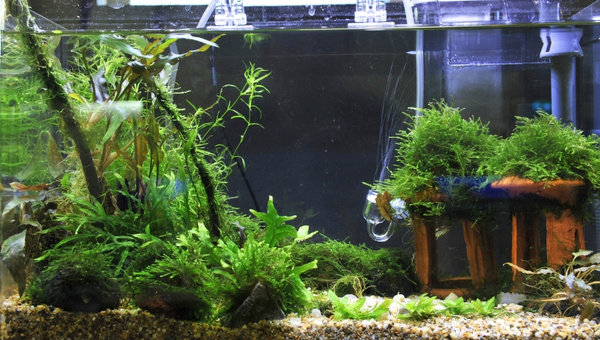
They also like to dig, so a layer of sand or gravel on the bottom of the tank is recommended. Female cichlids will also lay eggs in these pots or on large rocks at the tank’s bottom.
Also, check: Red Devil Cichlid 101: Best Detailed Care Guide
Filtration
Red Terror Cichlids are sensitive to organic waste, so your filtration system should be very efficient. A canister filter is a good option for a tank of this size. You should also change the tank water at least once a month, with partial water changes each week.
Some commonly suggested filters for these fish tanks are:
- AquaClear 50/70 Gallon Filter
- Fluval FX6 External Canister Filter
- Eheim Classic 2213 Canister Filter
Heating
The water temperature for these fishes should be around 77° to 84°F. You can use a heater to maintain this temperature.
Some commonly recommended heaters are:
- Aqueon Pro Submersible Aquarium Heater
- Hydor ETH 300W In-Line External Aquarium Heater
- Cobalt Neo-Therm Aquarium Heater
Lightning
These fishes come from murky waters and don’t need intense lighting. You can use a fluorescent light fixture with a daylight bulb to provide a natural-looking environment.
Some commonly recommended bulbs are:
- Zoo Med Aquatic Turtle and Reptile Fluorescent Bulb
- Univent UVB T8 Reptile Bulb
- Exo Terra Sun-Glo Neodymium Daylight Basking Spot Lamp
Check: Peacock Cichlid 101: Facts, Characteristics & Care Guide
Plants
Red Terror Cichlids are not plant-friendly and will uproot or eat most plants. If you want to add plants to your tank, choose hardy species that can survive in these conditions.
Some commonly recommended plants are:
- Anubias
- Bolbitis
- Java Fern
- Cryptocoryne
Also, check: Red Empress Cichlid 101: Best Care Guide
Cleaning the tank
You should perform a partial water change of 25% every other week. You will also need to vacuum the gravel and clean the filter media. Rinse the filter media in old tank water to prevent disrupting the beneficial bacteria colony.
To clean the tank, you will need the following:
- A sponge: A sponge can be used to wipe down the inside of the tank.
- A toothbrush: A toothbrush can be used to clean the filter.
- Freshwater: You will need fresh water to rinse off the sponge and toothbrush.
The steps for cleaning the tank are as follows:
- Remove the fish from the tank and put them in a temporary home.
- Remove all of the decorations from the tank.
- Use the sponge to wipe down the inside of the tank.
- Rinse the sponge and toothbrush with fresh water.
- Use the toothbrush to clean the filter.
- Rinse the sponge and toothbrush with fresh water.
- Add the decorations back to the tank.
- Add the fish back to the tank.
It is essential to clean the tank regularly to prevent the build-up of algae and bacteria. Algae and bacteria can be harmful to fish, and they can also cause the water to become cloudy.
Check: Red Empress Cichlid 101: Best Care Guide
Cleaning The Filter
It is essential to clean your filter regularly. A dirty filter can cause problems for your fish.
To clean your filter, you will need the following:
- A clean bucket: This is used to hold the old water.
- A garden hose: This is used to rinse the filter media.
- Filter media: This is used to replace the old media.
Red Terror Cichlid Common Possible Diseases
Red Terror Cichlids may develop internal parasites if the tank isn’t cleaned correctly or if they are stressed.
Some common parasites include:
- Flagellates
- Ciliates
- Acanthocephalans
- Nematodes
Treatment for parasites includes using parasiticides and performing regular water changes.
Red Terror Cichlids may also develop bacterial infections. Dirty tanks or injuries often cause bacterial infections.
Some common symptoms of a bacterial infection include:
- Fins rot
- Ulcers
- Popeye
- Dropsy
Treatment for bacterial infections includes using an antibiotic.
You can prevent these diseases by keeping your tank clean and stress-free.
Also, check: Cardinal Sulawesi Shrimp 101: Care Guide & Breeding Guide
Preventing Diseases
The best way to prevent diseases is to keep your tank clean and stress-free. You should perform a partial water change of 25% every other week and vacuum the gravel.
It would help to choose hardy plants that survive in these conditions. You can also prevent diseases by using parasiticides and performing regular water changes. You can also prevent bacterial infections by using an antibiotic.
Red Terror Cichlid Food and Diet
Red Terror Cichlids are carnivores and will eat most meaty foods.
Some good options for their diet include:
- Crustaceans
- Mollusks
- Worms
- Fish
- Squid
It would help if you fed your Red Terror Cichlids 2-3 times daily. It would be best to give them as much food as they can in 2 minutes.
You can also supplement your diet with vitamins and minerals. It would help if you were careful not to overfeed your Red Terror Cichlid. Leftover food in the substrate could infect the tank.
Check: Ultimate Dragon Goby 101: Care, Appearance, Food, Habitat & All
Red Terror Cichlid Tank Mates
Red Terror Cichlids are aggressive and should only be kept with other aggressive fish.
Some good tank mates for Red Terror Cichlids include:
- Oscars
- Jackson’s Chameleons
- Firemouth Cichlids
- Green Terror Cichlids
- Flowerhorn Cichlids
You should avoid keeping Red Terror Cichlids with peaceful or timid fish. They will likely be bullied and harassed by the Red Terror Cichlid. You can prevent a hierarchy by pairing Red Terror Cichlids with fish of similar size and temperament.
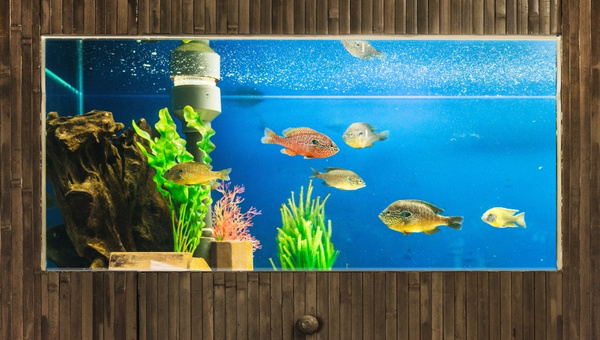
To prevent territorial fights, you shouldn’t overcrowd the tank. Your tank must have enough space for each fish to have its area. A good rule of thumb is 1 gallon per 1 inch of fish.
Red Terror Cichlids will also eat small crustaceans and shrimp. You should avoid keeping these animals with Red Terror Cichlids.
Advantages Of Having Red Terror Cichlid In Your Tank
The color is the most significant advantage of having a Red Terror Cichlid in your tank. Red Terror Cichlids are one of the most colorful fish you can keep. They are also very hardy and easy to care for.
Another advantage of keeping Red Terror Cichlids is that they are known to be good parents. They will protect their eggs and fry from other fish in the tank.
Red Terror Cichlids are also a good choice for beginner aquarium hobbyists. They are easy to care for and very hardy.
Check: Vampire Crab Ultimate Care Guide: Appearance, Food & Diet, Breeding, Lifespan & All
Disadvantages Of Having Red Terror Cichlid In Your Tank
One of the most significant disadvantages of keeping Red Terror Cichlids is their aggression. Red Terror Cichlids are very aggressive and may harass other fish in the tank. They are also known to be fin nippers.
Another disadvantage of keeping Red Terror Cichlids is that they need a lot of space. Red Terror Cichlids should be kept in tanks of at least 50 gallons.
Red Terror Cichlids are also known to be messy eaters. They will often leave food uneaten, which can pollute the water.
Also, check: Killifish Ultimate Care Guide, Size, Diet, Breeding, Tankmates & All
Conclusion
The Red Terror Cichlid is a good choice if you are looking for a colorful and hardy fish. They are also easy to care for and make good parents. However, you should be aware of their aggression and need for space.
You should only keep Red Terror Cichlids if you have a large tank and can provide plenty of hiding spots for other fish. It would help if you kept a close eye on your Red Terror Cichlids to ensure they’re happy in their environment.



